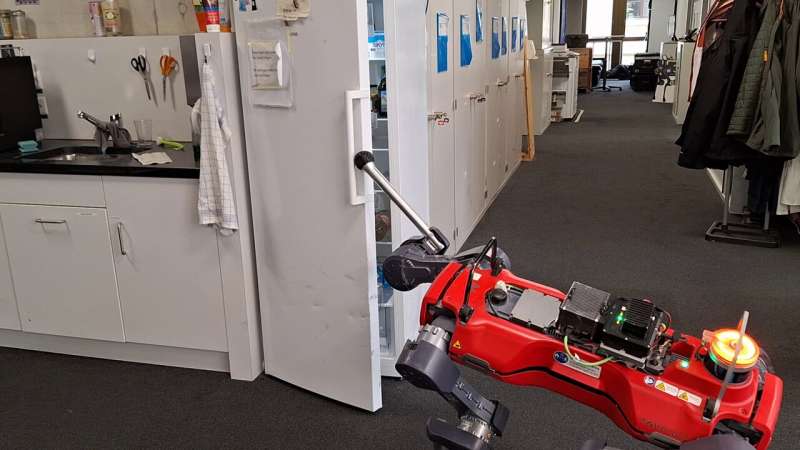March 21, 2024 feature
This article has been reviewed according to Science X's editorial process and policies. Editors have highlighted the following attributes while ensuring the content's credibility:
fact-checked
preprint
trusted source
proofread
A model that could broaden the manipulation skills of four-legged robots

Robotic systems have become increasingly sophisticated over the past decades, evolving from rudimental stiff robots to a wide range of soft, humanoid, animal-inspired robots. Legged robots, particularly quadrupeds, have been found to be particularly promising for tackling simple tasks at ground level, such as exploring environments and carrying objects.
Despite their promise, most legged robots are still limited in terms of how they can interact with objects and humans in their surroundings. Moreover, those that exhibit more advanced object manipulation skills are generally equipped with additional and sometimes bulky components, such as dedicated robotic arms or grippers.
A team of researchers at ETH Zurich recently introduced a new reinforcement learning–based model that could allow four-legged robots to interact with their surroundings in innovative ways, without requiring additional arms or manipulators. Their paper, published on the preprint server arXiv, shows that this model could allow quadruped robots to tackle more advanced tasks, such as opening a fridge and moving objects out of the way.
"The idea to use robotic legs for manipulation has been around for a while," Philip Arm, co-author of the paper, told Tech Xplore. "For example, robotic legs have been used to do inspections or to play soccer. However, most of these approaches were targeted at one single task."
The key objective of the recent work by Arm and his colleagues was to develop a versatile approach that would allow legged robots to tackle a wider range of real-world problems. The model they developed was trained using reinforcement learning, a well-known technique that has been widely used within the robotics community.
"The robot is tasked to bring its foot to a desired position, which it does many times in a simulation, learning and improving its skills over time," Arm explained. "We changed some parameters in the simulations we ran, such as where the foot should be placed and how hard the robot is disturbed while it tries to reach the target. With this approach, the robot became very robust to the uncertainties it would face in the real world."
In initial experiments, the researchers' model was found to perform very well, allowing a four-legged robot to effectively tackle object manipulation tasks that it could not complete before, including opening a fridge door, carrying objects, pressing a button, pushing obstacles out of its way and collecting rocks from the floor.
In contrast with other approaches to enhance the object manipulation skills of quadruped robots, the model teaches robots to use their whole body whenever necessary (e.g., leaning forward to reach a button with one of its feet).
"We found that the model even teaches a robot to hop so that it can reach a target that is a few meters away," Arm said. "We were actually surprised by how many tasks we could solve with the robot's foot, including opening a fridge door, Right now, the robot is still teleoperated, but if we manage to automate many of these tasks, it will extend the application range of legged robots without the need to change their hardware."
The new computational model developed by Arm and his collaborators could soon be further improved and trained on additional tasks. Once perfected and validated in fully automated robotic scenarios, it could significantly broaden the real-world applications of legged robots, for instance allowing robots used to conduct inspections of warehouses or infrastructure to push buttons, move levers, and open doors independently.
In their next studies, the researchers will continue to work towards this goal, by increasing their approach's autonomy and trying to automate more tasks, including object grasping and opening other types of doors.
More information: Philip Arm et al, Pedipulate: Enabling Manipulation Skills using a Quadruped Robot's Leg, arXiv (2024). DOI: 10.48550/arxiv.2402.10837
© 2024 Science X Network


















